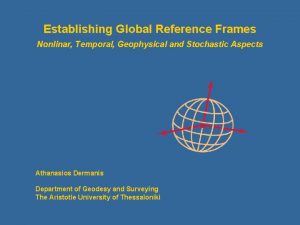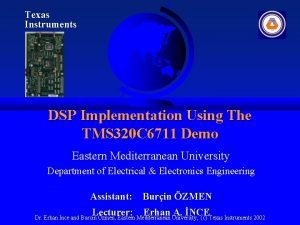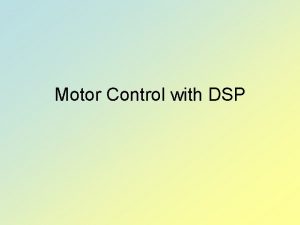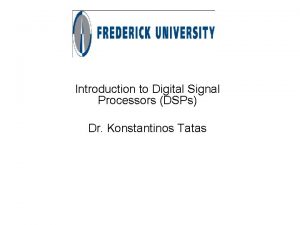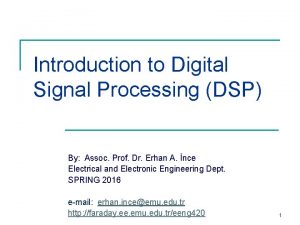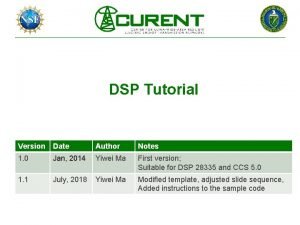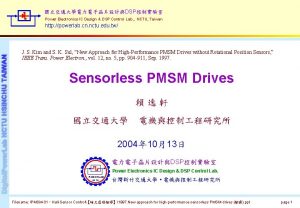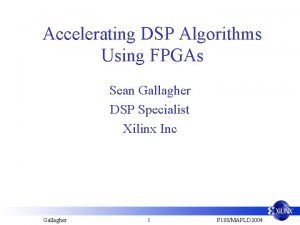Reference Solution of DSP Test 2 2005 1




![Problem 2 - Solution • The output xr[n] = x[n] if no aliasing occurs Problem 2 - Solution • The output xr[n] = x[n] if no aliasing occurs](https://slidetodoc.com/presentation_image_h2/b4c7653a89163f95cb10f8e2fc8f70d3/image-5.jpg)



![Problem 4 – Solution (1/2) x[n] H(z) y[n] ↓M w[n] = y[n. M] • Problem 4 – Solution (1/2) x[n] H(z) y[n] ↓M w[n] = y[n. M] •](https://slidetodoc.com/presentation_image_h2/b4c7653a89163f95cb10f8e2fc8f70d3/image-9.jpg)
![Problem 4 – Solution (2/2) x[n] Z 0 (z. M) x[n] ↓M z-1 Z Problem 4 – Solution (2/2) x[n] Z 0 (z. M) x[n] ↓M z-1 Z](https://slidetodoc.com/presentation_image_h2/b4c7653a89163f95cb10f8e2fc8f70d3/image-10.jpg)



![Problem 6 - Solution x[n] y[n] z-1 1/2 5/6 z-1 1/2 1/6 14 Problem 6 - Solution x[n] y[n] z-1 1/2 5/6 z-1 1/2 1/6 14](https://slidetodoc.com/presentation_image_h2/b4c7653a89163f95cb10f8e2fc8f70d3/image-14.jpg)
- Slides: 14

Reference Solution of DSP Test 2 2005 1

Problem 1 2

Problem 1 - Solution • (a) The Nyquist rate is 2 times the highest frequency. –→ T=1/(5 k. Hz x 2) = 1/10000 sec. • (b) 3

Problem 2 4
![Problem 2 Solution The output xrn xn if no aliasing occurs Problem 2 - Solution • The output xr[n] = x[n] if no aliasing occurs](https://slidetodoc.com/presentation_image_h2/b4c7653a89163f95cb10f8e2fc8f70d3/image-5.jpg)
Problem 2 - Solution • The output xr[n] = x[n] if no aliasing occurs as result of downsampling. That is, X(ejw) = 0 for pi/3 ≦|w|≦pi. • (a) X(ejw) has impulses at w = ± pi/4, so there is no aliasing. xr[n] = x[n]. • (b) X(ejw) has impulses at w = ± pi/2, so there is aliasing. xr[n] ≠ x[n]. 5

Problem 3 6

Problem 3 - Solution • (a) A random process that satisfies: – 1) its mean is constant. – 2) its autocovariance is a function that depends only on the distance in placement. • (b) A random process for which time averages equal ensemble averages. • (c) A function that describes the average power of a signal over a particular frequency band. • (d) A random process with a flat power spectral density. • (e) A bit reduction technique to minimize quantization error. 7

Problem 4 8
![Problem 4 Solution 12 xn Hz yn M wn yn M Problem 4 – Solution (1/2) x[n] H(z) y[n] ↓M w[n] = y[n. M] •](https://slidetodoc.com/presentation_image_h2/b4c7653a89163f95cb10f8e2fc8f70d3/image-9.jpg)
Problem 4 – Solution (1/2) x[n] H(z) y[n] ↓M w[n] = y[n. M] • Observation 1: The goal of the system is to sample y[n] every M data points. – Apply H(z) only on the 1/M signal portions will effectively reduce the needed computational operations. • Observation 2: The two systems below are equivalent. H(z) ↓M x[n] y[n] ↓M y’ [n] w[n] H(z) w’ [n] 9
![Problem 4 Solution 22 xn Z 0 z M xn M z1 Z Problem 4 – Solution (2/2) x[n] Z 0 (z. M) x[n] ↓M z-1 Z](https://slidetodoc.com/presentation_image_h2/b4c7653a89163f95cb10f8e2fc8f70d3/image-10.jpg)
Problem 4 – Solution (2/2) x[n] Z 0 (z. M) x[n] ↓M z-1 Z 0(z. M) ↓M Z 1(z. M) z-1 Z 1(z. M) ↓M + z-1 ↓M ZM+1 (z. M) ↓M original y[n] + z-1 ↓M y[n] ZM+1(z. M) answer 10

Problem 5 11

Problem 5 - Solution • (a) Yes. The poles z = ±j(0. 9) are inside the unit circle so the system is stable. • (b) minimum phase poles & zeros outside unit circle 12

Problem 6 13
![Problem 6 Solution xn yn z1 12 56 z1 12 16 14 Problem 6 - Solution x[n] y[n] z-1 1/2 5/6 z-1 1/2 1/6 14](https://slidetodoc.com/presentation_image_h2/b4c7653a89163f95cb10f8e2fc8f70d3/image-14.jpg)
Problem 6 - Solution x[n] y[n] z-1 1/2 5/6 z-1 1/2 1/6 14
 Reference node and non reference node
Reference node and non reference node Reference node and non reference node
Reference node and non reference node Global reference solution
Global reference solution Vapour pressure composition curve for non ideal solution
Vapour pressure composition curve for non ideal solution Variable precision dsp
Variable precision dsp Nadd dsp certification
Nadd dsp certification Tms texas instruments
Tms texas instruments Dbhds dsp orientation training
Dbhds dsp orientation training Nadd dsp certification
Nadd dsp certification Dsp motor control
Dsp motor control Dsp vs microprocessor
Dsp vs microprocessor Frequency warping in dsp
Frequency warping in dsp Introduction to dsp
Introduction to dsp Ess dsp
Ess dsp Dsp algorithms tutorial
Dsp algorithms tutorial


